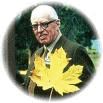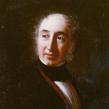Comments
from Mr. PGC: Throughout
history, many people have made lasting contributions to the
world of plants. In these pages, we hope to pay tribute to
some of them. Our concentration will be primarily on those
who have introduced plants to the gardening world, those who
have helped spread the word about gardening and those who
have made significant contributions to landscaping and
landscaping design around the world.
This list will be constantly growing as we add
new names. If you have someone who you think should be on
the list, please send us an
Email.
|
|
|
 |
 |
|
|
 |
|
Sir Harold
Hillier |
|
|
 |
|
 |
The genus,
Halesia (Silverbell), was named in honor of this eminent
English philosopher. He did studies of the physiology of
vegetables which were published in 1728.
|
|
 |
|
 |
 American physician and plant collector
from Bristol, Rhode Island, he was a graduate of the Harvard
Medical School. He made a trip to
China in 1846 and to
Japan in
1855. American physician and plant collector
from Bristol, Rhode Island, he was a graduate of the Harvard
Medical School. He made a trip to
China in 1846 and to
Japan in
1855.
He sent the first plants
of Japanese Honeysuckle a.k.a. Hall's Honeysuckle (Lonicera
japonica) and Japanese Yew (Taxus cuspidata) to
the
United States from
Japan. The first double flowering
crabapple,
Malus halliana parkmanii is said to have been
introduced by Hall from Japan.
|
|
 |
|
 |
 Sir Thomas was a wealthy Quaker and for 20 years a silk
merchant in
China. In 1867 he bought the Palazzo Orengo on the
Italian Riviera around which, with his eminent botanist brother
Daniel, he created the celebrated garden of La Mortola. In 1960,
the garden was given to the care of the Genoa University. Sir Thomas was a wealthy Quaker and for 20 years a silk
merchant in
China. In 1867 he bought the Palazzo Orengo on the
Italian Riviera around which, with his eminent botanist brother
Daniel, he created the celebrated garden of La Mortola. In 1960,
the garden was given to the care of the Genoa University.
On the
death of E.H. Wilson in 1902, Hanbury bought his
Oakwood Experimental
Garden at Wisley, England and the
following year presented it in trust to the
Royal
Horticultural Society
to be open to the public.

|
|
 |
|
 |
Hartweg worked at the
Jardin des Plantes in
Paris before heading to
North
America and
South America on several plant collection expeditions. He
introduced the species
Cupressus
macrocarpa.
Plants named for him include
Pinus
hartwegii,
Penstemon hartwegii,
Fuchsia hartwegii and
Asarum hartwegii.

|
|
 |
|
 |
 French
city planner in charge of the massive alteration to the layout
of the
City of Paris instituted by Napoleon III in the mid-1800's.
He was responsible for the enhancement of monuments, open spaces
and vistas in the City. The Place de l'Opéra, the Étoile, and
the Place de la Nation were created under his guidance. The
Bois de Boulogne and a number of
smaller parks were completed then also. French
city planner in charge of the massive alteration to the layout
of the
City of Paris instituted by Napoleon III in the mid-1800's.
He was responsible for the enhancement of monuments, open spaces
and vistas in the City. The Place de l'Opéra, the Étoile, and
the Place de la Nation were created under his guidance. The
Bois de Boulogne and a number of
smaller parks were completed then also.

|
|
 |
|
 |
 Owner
of Terra Nova Nurseries in Portland, Oregon, Heims is an
internationally known plant breeder and collector. His
specialties are the genera,
Heuchera and
Tiarella. Owner
of Terra Nova Nurseries in Portland, Oregon, Heims is an
internationally known plant breeder and collector. His
specialties are the genera,
Heuchera and
Tiarella.
Plants he has
introduced include
Echinacea purpurea 'Ruby Giant',
Heuchera 'Amber Waves',
Heuchera 'Amethyst
Myst',
Heuchera 'Cherries Jubilee',
Heuchera
'Key Lime Pie',
Heuchera 'Plum Pudding',
Hosta 'Jade Cascade', and
Hosta 'Pacific Blue Edger'.

|
|
 |
|
 |
 Irish
doctor who worked for the Chinese Customs Service in the
1880s. As an avid botanist, he sent 15,000 plant specimens
to the gardens at the
Royal Botanic Gardens at Kew,
England. He became acquainted with another
great plant collector,
E.H.
Wilson during that time. Irish
doctor who worked for the Chinese Customs Service in the
1880s. As an avid botanist, he sent 15,000 plant specimens
to the gardens at the
Royal Botanic Gardens at Kew,
England. He became acquainted with another
great plant collector,
E.H.
Wilson during that time.
After having
studied forestry in
France, in collaboration with
fellow botanist,
Henry John Elwes.
Augustine wrote his great book, Trees of Great Britain
and Ireland, in 7 volumes. He is associated with A. C. Forbes
in developing
plantings at Avondale Forest Park, County Wicklow, Ireland.
Many plants bear his name including
Acer henryi,
Lilium henryi,
Lonicera henryi,
Parthenocissus
henryana, Sinowilsonia henryi,
Rubus henryi,
Tilia henryana, Emmenopterys henryi
and
Rhododendron augustinii.
He also introduced
Rodgersia
aesculifolia and
Rodgersia pinnata.

|
|
 |
|
 |
Member of Parliament, poet, classicist, rector of Spofforth and Dean of the
Collegiate Church of Manchester,
England. William Herbert cultivated
and hybridized
bulbous plants.
His name is
commemorated in the genus, Herbertia, a group of iris
shaped bulb plants.

|
|
 |
|
 |
)
 The genus,
Heuchera (Coral Bells), is named after this 18th
century German botanist. The genus,
Heuchera (Coral Bells), is named after this 18th
century German botanist.

|
|
 |
|
 |
 He
was superintendent of the Cheyenne Horticultural Field
Station in Wyoming during the 1930s and 40s. There, he tested over 20,000
species and cultivars of plants for their cold hardiness and
suitability for use in the Great Plains Region of the
United States.
In 1959, he became the director of the Denver Botanical
Garden in Colorado. He
was superintendent of the Cheyenne Horticultural Field
Station in Wyoming during the 1930s and 40s. There, he tested over 20,000
species and cultivars of plants for their cold hardiness and
suitability for use in the Great Plains Region of the
United States.
In 1959, he became the director of the Denver Botanical
Garden in Colorado.
|
|
 |
|
 |
 British nurseryman, founder of the
Hillier Arboretum
and
originator of dozens of superior ornamental plant cultivars,
Hillier was also author of
the well known Hillier's Manual. He is often considered to be one of the 20th centuries
leading experts on woody plants. British nurseryman, founder of the
Hillier Arboretum
and
originator of dozens of superior ornamental plant cultivars,
Hillier was also author of
the well known Hillier's Manual. He is often considered to be one of the 20th centuries
leading experts on woody plants.
 Plants associated with the Hillier family and
nursery include
Abutilon x suntense 'Jermyns',
Ceanothus 'Blue Mounds',
Cotinus 'Grace',
Daphne
'Valerie Hillier', Eucryphia x hilleri 'Winton', X
Halimiocistus wintonensis,
Lonicera x purpusii
'Winter Beauty',
Malus x scheideckeri 'Hilleri',
Phygelius x rectus 'Winchester Fanfare',
Robinia x slavinii 'Hilleri',
Thuja plicata 'Hilleri',
Tilia 'Harold Hilleri',
Ulmus x hollandica
'Jacqueline Hillier' and
Viburnum x hilleri
'Winton'. Plants associated with the Hillier family and
nursery include
Abutilon x suntense 'Jermyns',
Ceanothus 'Blue Mounds',
Cotinus 'Grace',
Daphne
'Valerie Hillier', Eucryphia x hilleri 'Winton', X
Halimiocistus wintonensis,
Lonicera x purpusii
'Winter Beauty',
Malus x scheideckeri 'Hilleri',
Phygelius x rectus 'Winchester Fanfare',
Robinia x slavinii 'Hilleri',
Thuja plicata 'Hilleri',
Tilia 'Harold Hilleri',
Ulmus x hollandica
'Jacqueline Hillier' and
Viburnum x hilleri
'Winton'.

|
|
 |
|
 |
 Founder
of Heronswood Nursery (now owned by Burpee Seed Co.) near
Seattle,
Washington, Hinkley is an internationally known plant breeder
and collector. He has travelled extensively around the world in
search of new plants to introduce into the plant trade. Founder
of Heronswood Nursery (now owned by Burpee Seed Co.) near
Seattle,
Washington, Hinkley is an internationally known plant breeder
and collector. He has travelled extensively around the world in
search of new plants to introduce into the plant trade.
Plants named for
the nursery include
Cercidiphyllum japonicum 'Herronswood
Globe' and
Tiarella wherryi
'Heronswood Mist'.

|
|
 |
|
 |
 Garden
writer, lecturer and designer, Penelope Hobhouse is the author
of several popular gardening books. She has designed gardens
across
Europe and in the
United States. For a number of years,
she was in charge of the National Trust Gardens at Tintinhull
House in Somerset,
England. Garden
writer, lecturer and designer, Penelope Hobhouse is the author
of several popular gardening books. She has designed gardens
across
Europe and in the
United States. For a number of years,
she was in charge of the National Trust Gardens at Tintinhull
House in Somerset,
England.
Her books include Colour
in Your Garden', Plants in Garden History, Penelope Hobhouse on Gardening,
Penelope Hobhouse’s Garden Designs, and Penelope Hobhouse’s
Natural Planting.
The plant
Oenothera 'Penlope Hobhouse' is
named for her.

|
|
 |
|
 |
 

|
|
 |
|
 |

 Son of Sir William
Hooker, who he succeeded as Director of the
Royal
Botanic Gardens at Kew,
England. Sir Joseph
Hooker was a noted plant explorer credited with introducing the
magnificent Sikkim series of
rhododendrons from the
Himalayas in 1850. He introduced the Himalayan birch
(Betula
utilis) and
reported amongst other trees, the biggest of all magnolias,
Magnolia campbellii. Son of Sir William
Hooker, who he succeeded as Director of the
Royal
Botanic Gardens at Kew,
England. Sir Joseph
Hooker was a noted plant explorer credited with introducing the
magnificent Sikkim series of
rhododendrons from the
Himalayas in 1850. He introduced the Himalayan birch
(Betula
utilis) and
reported amongst other trees, the biggest of all magnolias,
Magnolia campbellii.
Hooker published part
one of his Handbook of the New Zeeland Flora in 1864 and
part two in 1868.

|
|
 |
|
 |
 One of the worlds great
early botanists, he became the first Director of
Royal
Botanic Gardens at Kew,
England.
His son, Sir Joseph Hooker (see above), followed him as Director of Kew. One of the worlds great
early botanists, he became the first Director of
Royal
Botanic Gardens at Kew,
England.
His son, Sir Joseph Hooker (see above), followed him as Director of Kew.

|
|
 |
|
 |


|
 |
 |
 Dr.
Hylander was a Swedish scientist who wrote the book, "The Genus
Hosta in Swedish Gardens: With Contributions to the Taxonomy,
Nomenclature and Botanical History of the Genus" in 1954. He
introduced several cultivars including H. 'Ellerbroek',
H. 'Fortunei
Aureomarginata' and H. 'Undulata Univitata'. Dr.
Hylander was a Swedish scientist who wrote the book, "The Genus
Hosta in Swedish Gardens: With Contributions to the Taxonomy,
Nomenclature and Botanical History of the Genus" in 1954. He
introduced several cultivars including H. 'Ellerbroek',
H. 'Fortunei
Aureomarginata' and H. 'Undulata Univitata'.
|

|
|

